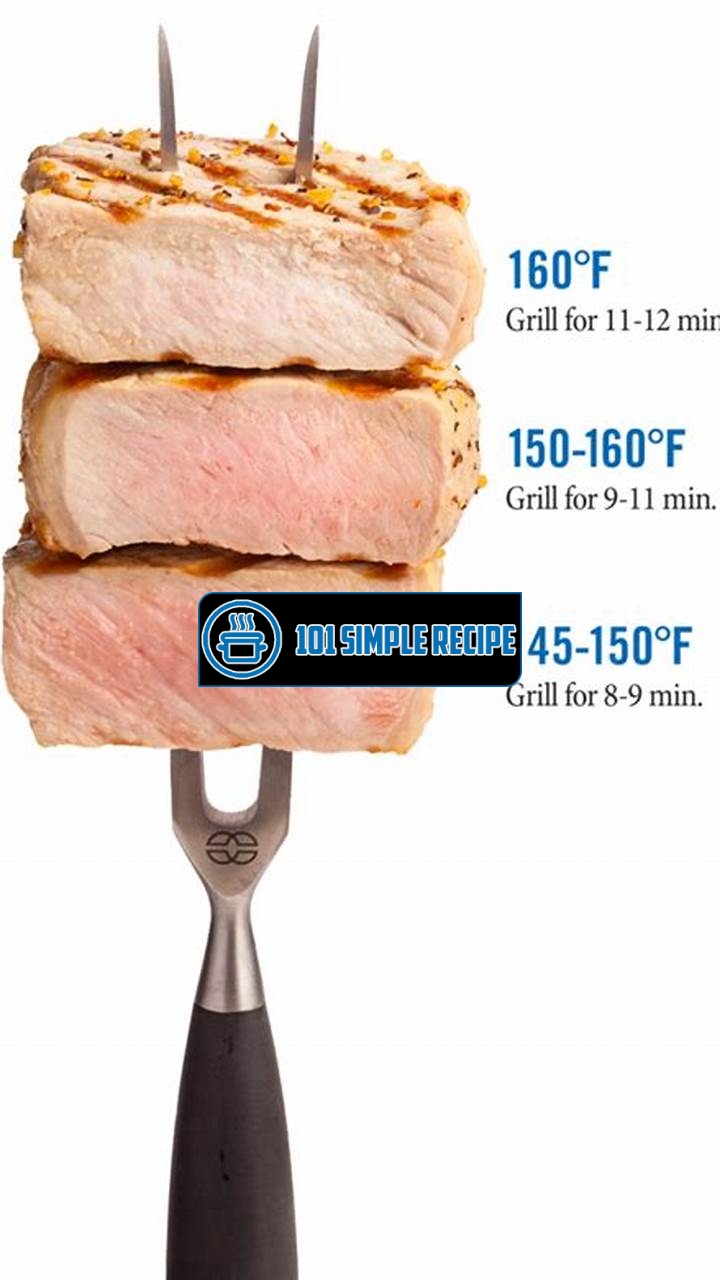Are you eager to perfect your pork tenderloin recipe? Look no further! In this article, we will guide you through discovering the ideal temperature for cooking pork tenderloin, ensuring that your meat is juicy, flavorful, and perfectly cooked every time. Whether you’re hosting a dinner party or simply preparing a delicious meal for your family, understanding the correct temperature is crucial to achieve the best results. So, grab your apron and let’s explore the world of pork tenderloin cooking! ️

Understanding the Proper Temperature for Pork Tenderloin
When it comes to cooking pork tenderloin, it is crucial to understand the proper temperature to ensure a perfectly cooked and safe-to-eat dish. Pork is a delicate meat that needs to be cooked thoroughly to eliminate any potential health risks. By cooking it at the right temperature, you can achieve a tender and succulent pork tenderloin that will delight your taste buds.
Cooking pork tenderloin at the ideal temperature is essential to ensure both safety and taste. Failure to cook it properly can result in an undercooked or overcooked dish, which can be unappealing and potentially harmful to your health. By following the recommended temperature guidelines, you can guarantee a delicious and safe-to-eat pork tenderloin.
Why Temperature Matters in Cooking
️ Temperature plays a vital role in cooking as it affects the texture, taste, and safety of the food. When cooking meat, including pork tenderloin, the internal temperature determines its doneness. Different temperatures yield different results. Cooking pork tenderloin at the right temperature ensures that it is cooked thoroughly, killing any potential harmful bacteria or parasites that could cause foodborne illnesses.
️ Additionally, cooking at the proper temperature helps retain the natural flavors and moisture of the pork. If cooked at too high a temperature, the tenderloin may dry out, resulting in a tough and flavorless meat. On the other hand, cooking it at too low a temperature may lead to an undercooked and potentially unsafe dish.
The Recommended Internal Temperature
️ The United States Department of Agriculture (USDA) recommends cooking pork tenderloin to an internal temperature of 145°F (63°C). At this temperature, the meat is considered safe to eat, provided the internal temperature is maintained for at least three minutes. This guideline ensures that the pork is thoroughly cooked, reducing the risk of foodborne illnesses, while still retaining its juiciness and flavor.
️ However, if you prefer your pork tenderloin to be well-done, you can cook it to an internal temperature of 160°F (71°C). It is essential to note that cooking it to a higher temperature may result in a slightly drier texture, but it can still be incredibly delicious when cooked with appropriate seasonings and marinades to enhance the flavor.
Factors to Consider in Determining Cooking Temperature
️ Several factors can influence the ideal cooking temperature for pork tenderloin. The thickness and size of the tenderloin play a significant role. Thicker cuts will require a lower cooking temperature and a longer cooking time to ensure they are cooked evenly and thoroughly. Conversely, thinner cuts may need a higher temperature for faster cooking to prevent drying out.
️ Another important factor to consider is whether the pork tenderloin is fresh or frozen. Frozen tenderloin will require a slightly higher cooking temperature and additional cooking time to ensure it is safely cooked through. It is crucial to defrost the meat thoroughly before cooking to ensure even cooking and avoid any potential issues.
️ Lastly, consider the cooking method you plan to use. Different cooking methods, such as grilling, roasting, or pan-searing, may require different temperatures to achieve the desired results. It is best to consult specific recipes or cooking guides for the recommended cooking temperatures based on your chosen method.
Note: It is always recommended to use a meat thermometer to accurately measure the internal temperature of your pork tenderloin. This ensures that it is safely cooked and avoids the risk of undercooking or overcooking.
By understanding the proper temperature for pork tenderloin and considering the various factors involved, you can confidently cook a delicious and perfectly cooked pork tenderloin every time. Remember to prioritize food safety by ensuring the meat reaches the recommended internal temperature, and let your taste buds rejoice in the flavorful results.
Safe Food Handling Practices for Pork Tenderloin
When it comes to cooking pork tenderloin, it is crucial to follow safe food handling practices to prevent foodborne illnesses and ensure the best results. By adhering to the following rules and guidelines, you can minimize the risk of contamination and enjoy a delicious and safe meal.
Importance of Proper Handling
Proper handling of pork tenderloin is essential because it reduces the potential for bacterial growth and cross-contamination. By practicing good hygiene and following safe food handling practices, you can protect yourself and your loved ones from foodborne illnesses.
- Wash your hands thoroughly with soap and water before and after handling raw pork tenderloin to eliminate any bacteria or pathogens on your hands.
- Use separate cutting boards, utensils, and plates for raw and cooked pork tenderloin to avoid cross-contamination.
- ️ Keep pork tenderloin refrigerated below 40°F (4°C) until you are ready to cook it. Leaving it at room temperature for too long can encourage bacterial growth.
- ️ Avoid touching ready-to-eat foods or surfaces with hands contaminated with raw pork tenderloin juices to prevent the spread of harmful bacteria.
Safe Storage of Pork Tenderloin
Proper storage of pork tenderloin is essential to maintain its quality and prevent the growth of bacteria.
- Store raw pork tenderloin in a sealed container or wrap it tightly in plastic wrap to prevent air exposure and freezer burn.
- If you plan to use the pork tenderloin within a couple of days, keep it in the refrigerator’s meat compartment or on the bottom shelf, away from other food items to prevent cross-contamination.
- ❄️ If you won’t be using the pork tenderloin within a few days, it’s best to freeze it. Wrap it tightly in freezer-safe packaging to protect it from freezer burn.
- Label the storage container or package with the date of freezing to ensure you use it within the recommended timeframe.
Preparation Practices to Minimize Contamination
During the preparation of pork tenderloin, it is crucial to follow specific practices that minimize the risk of contamination.
- Use clean and sanitized utensils and equipment when handling and preparing pork tenderloin.
- If you plan to marinate the pork tenderloin, do it in a shallow dish or a sealed plastic bag in the refrigerator. Discard any leftover marinade that has come into contact with raw pork.
- ️ Thaw frozen pork tenderloin in the refrigerator overnight or use the defrost function on your microwave. Avoid thawing at room temperature, as it can promote bacterial growth.
- Rinse pork tenderloin before cooking, but avoid rinsing it under running water, as it can spread bacteria. Instead, pat it dry with paper towels after rinsing.
- Clean and sanitize all surfaces, utensils, and equipment that come into contact with raw pork tenderloin to prevent cross-contamination.
By following these safe food handling practices, you can ensure that your pork tenderloin is cooked to perfection while minimizing the risk of foodborne illnesses. Good hygiene and proper handling techniques are essential for a delicious and safe dining experience.
Methods for Cooking Pork Tenderloin
When it comes to cooking pork tenderloin, there are several methods you can use to enhance its flavor, texture, and overall appeal. Whether you prefer the smoky taste of grilled meat, the tenderness of baked pork, or the crispy exterior of pan-frying, each method offers a unique culinary experience. Discover the ideal temperature for pork tenderloin and try out these cooking techniques to create a delicious and satisfying meal.
Grilling Pork Tenderloin to Perfection
Grilling is a popular method for cooking pork tenderloin, as it imparts a smoky flavor and creates beautiful grill marks on the meat. To achieve the ideal temperature for grilled pork tenderloin, preheat your grill to medium-high heat, around 400°F (204°C).
- Season the tenderloin with your preferred spices or marinade to add extra flavor. Common choices include garlic, rosemary, thyme, and black pepper.
- Place the pork tenderloin on the preheated grill and cook for about 15-20 minutes, turning occasionally, until the internal temperature reaches 145°F (63°C).
- Always use a meat thermometer to ensure the pork is cooked to the correct temperature. Let the meat rest for a few minutes before slicing to retain its juices.
Grilled pork tenderloin pairs well with a variety of side dishes, such as grilled vegetables, corn on the cob, or a fresh salad. It’s a versatile and delicious option for any barbecue or outdoor gathering.
Baking Pork Tenderloin for Tenderness
Baking is another fantastic cooking method for pork tenderloin, as it helps to lock in the meat’s natural juices and creates a tender and flavorful result. The ideal temperature for baking pork tenderloin is 375°F (190°C).
- Start by seasoning the pork tenderloin with your favorite herbs and spices. You can use a blend of garlic powder, paprika, thyme, and salt for a delicious flavor profile.
- Place the seasoned tenderloin on a baking sheet lined with foil or parchment paper to prevent sticking.
- Bake the pork for approximately 25-30 minutes, or until the internal temperature reaches 145°F (63°C).
- Allow the meat to rest for a few minutes before slicing. This step ensures that the juices redistribute throughout the pork, resulting in a moist and tender texture.
Baked pork tenderloin is a versatile protein that can be served alongside roasted vegetables, mashed potatoes, or even sliced and used in sandwiches or wraps. It’s a crowd-pleasing option that is relatively easy to prepare.
Searing and Pan-Frying for a Crispy Exterior
If you’re a fan of a crispy exterior on your pork tenderloin, searing and pan-frying is the way to go. This method locks in the meat’s juices while creating a delightful crunch. The ideal temperature for searing and pan-frying pork tenderloin is medium-high heat, around 375°F (190°C).
- Season the tenderloin with your desired spices, such as garlic powder, onion powder, salt, and black pepper.
- Heat a skillet or frying pan with a bit of oil over medium-high heat. Once hot, add the pork tenderloin and sear each side for about 2-3 minutes, until a golden crust forms.
- Reduce the heat to medium and continue cooking for another 10-15 minutes, or until the internal temperature reaches 145°F (63°C).
- Remove the pork from the pan and let it rest for a few minutes. This step allows the juices to redistribute and ensures a juicy and delicious final result.
Searing and pan-frying pork tenderloin creates a mouthwatering texture that combines a crispy exterior with tender and juicy meat. Serve it with your favorite side dishes, such as roasted potatoes, steamed vegetables, or a refreshing salad.
Experiment with Cooking Methods for Perfect Pork Tenderloin
Now that you know the ideal temperature for pork tenderloin and have explored different cooking methods, it’s time to get creative in the kitchen. Try grilling, baking, or searing and pan-frying your pork tenderloin to discover which technique you prefer. Each method offers its own unique flavors and textures, allowing you to create a meal that suits your taste buds and culinary preferences. So gather your ingredients, prepare your meat, and start cooking. Enjoy the delicious journey of exploring the many possibilities of pork tenderloin!
Tips and Tricks for Cooking Pork Tenderloin
When it comes to cooking pork tenderloin, there are a few tips and tricks that can help you achieve the perfect results. Whether you’re a seasoned chef or just starting out in the kitchen, these expert insights will ensure your pork tenderloin is juicy, tender, and packed with flavor.
Brining for Enhanced Moisture and Flavor
One of the best ways to enhance the moisture and flavor of your pork tenderloin is to brine it before cooking. Brining involves soaking the meat in a combination of water, salt, sugar, and spices to infuse it with moisture and flavor. This process helps the pork tenderloin retain its juiciness during cooking.
Tip: To make a basic brine, combine 4 cups of water with ¼ cup of salt and ¼ cup of sugar. Add your favorite spices and herbs for additional flavor.
When brining pork tenderloin, it’s important to keep it refrigerated for at least 1 hour, but no more than 4 hours. This ensures that the meat absorbs the flavors without becoming overly salty. After brining, rinse the pork tenderloin thoroughly and pat it dry before cooking.
Seasoning and Marinade Recommendations
Seasoning is key when it comes to enhancing the taste of pork tenderloin. A simple rub of salt and pepper can go a long way, but you can also get creative with different herbs, spices, and marinades. Here are some recommendations:
- Herbs and spices: Try a combination of garlic powder, onion powder, smoked paprika, and thyme for a flavorful rub.
- Marinades: Marinating the pork tenderloin in a mixture of lemon juice, soy sauce, honey, and minced garlic can add a tangy and sweet flavor.
- ️ Spicy kick: For those who enjoy some heat, a blend of chili powder, cayenne pepper, and cumin can give your pork tenderloin a spicy kick.
When seasoning or marinating the pork tenderloin, be sure to coat the entire surface evenly. Let it sit in the seasoning or marinade for at least 30 minutes or overnight in the refrigerator for a more intense flavor. Remember to remove the pork tenderloin from the refrigerator and let it come to room temperature before cooking.
Resting and Carving for Juicy and Tender Pork
Resting and carving the cooked pork tenderloin properly is essential for maintaining its juiciness and tenderness. After removing the pork tenderloin from the oven or grill, allow it to rest for about 5-10 minutes before slicing. This allows the juices to redistribute throughout the meat, resulting in a moist and flavorful final product.
Tip: To prevent the pork tenderloin from drying out, cover it loosely with foil while it rests.
When it’s time to slice the pork tenderloin, make sure to do it against the grain. This helps break down the muscle fibers and ensures each bite is tender and delicious. Use a sharp knife and slice the tenderloin into thin slices for optimal results.
Bonus Tip: If you want to take your pork tenderloin to the next level, consider stuffing it with your favorite ingredients. Whether it’s cheese, herbs, or even fruits like apples or dried cranberries, the possibilities are endless and can add an extra burst of flavor.
By following these tips and tricks, you’ll discover the ideal temperature for pork tenderloin and achieve deliciously juicy and tender results every time. Remember to experiment with different flavors and techniques to find your personal favorite way of cooking pork tenderloin. Happy cooking!
Pork tenderloin is a versatile and delicious cut of meat that can be cooked in a variety of ways. If you’re wondering what temp should pork tenderloin be, you’ll find the answer here. The juicy and flavorful meat will be perfectly cooked when it reaches an internal temperature of 145°F (63°C). This recipe will guide you step-by-step on how to achieve the desired temperature for your pork tenderloin. So get ready to impress your guests with a perfectly cooked pork tenderloin!
Common Mistakes to Avoid when Cooking Pork Tenderloin
When it comes to cooking pork tenderloin, there are several common mistakes that can easily be avoided. By knowing what these mistakes are and how to prevent them, you can ensure that your pork tenderloin turns out perfectly cooked and delicious every time. Let’s take a closer look at these mistakes and learn how to avoid them.
Overcooking and Dryness
One of the most common mistakes when cooking pork tenderloin is overcooking it, which often leads to dry and flavorless meat. To avoid this, it is crucial to cook the pork tenderloin to the ideal internal temperature. The recommended temperature for pork tenderloin is 145°F (63°C), as measured by a meat thermometer. This allows the meat to be cooked through while still remaining juicy and tender. It is important to note that the temperature will continue to rise slightly after removing the pork from the heat, so be sure to take it out of the oven or grill when it reaches around 140°F (60°C).
Tip: Use a meat thermometer to ensure the pork tenderloin is cooked to the perfect temperature of 145°F (63°C) for juicy, tender meat.
Undercooking and Safety Concerns
Another mistake to avoid is undercooking the pork tenderloin. Undercooked pork can pose a risk of foodborne illness, specifically from the presence of harmful bacteria such as salmonella and trichinella. To ensure the safety of your dish, it is essential to cook the pork tenderloin thoroughly. As mentioned earlier, the ideal internal temperature of cooked pork tenderloin should reach 145°F (63°C). By using a meat thermometer, you can accurately determine when the pork is safe to eat.
Note: Properly cooked pork tenderloin should reach an internal temperature of 145°F (63°C) to ensure it is safe to consume.
Failure to Properly Rest the Meat
One mistake that is often overlooked when cooking pork tenderloin is the failure to properly rest the meat after cooking. Resting allows the juices to redistribute within the meat, resulting in a more flavorful and evenly cooked dish. It also helps to retain moisture, preventing the pork from becoming dry. After removing the pork tenderloin from the heat source, let it rest for at least 5 minutes before slicing or serving.
Tip: Allowing the pork tenderloin to rest for a few minutes before slicing helps retain moisture and ensures a more flavorful and tender meat.
By being aware of these common mistakes and taking the necessary precautions, you can avoid them when cooking pork tenderloin. Remember to cook the meat to the proper internal temperature, avoid undercooking or overcooking, and allow the meat to rest before serving. Following these steps will result in a delicious and perfectly cooked pork tenderloin every time.
Thank you for taking the time to read our article about what temperature pork tenderloin should be cooked to. We hope that you found the information helpful in ensuring that your pork tenderloin turns out perfectly cooked and delicious. If you have any other questions or need further assistance, please don’t hesitate to reach out. And don’t forget to check back for more cooking tips and recipes in the future. Happy cooking!
Frequently Asked Questions
Here are some frequently asked questions about cooking the perfect pork tenderloin:
| No. | Questions | Answers |
|---|---|---|
| 1. | What is the recommended internal temperature for pork tenderloin? | The recommended internal temperature for pork tenderloin is 145°F (63°C) with a 3-minute rest time. |
| 2. | How do I check the temperature of a pork tenderloin? | To check the temperature of a pork tenderloin, insert an instant-read thermometer into the thickest part of the meat. It should read 145°F (63°C) when fully cooked. |
| 3. | Is it necessary to rest pork tenderloin after cooking? | Yes, it is important to let the pork tenderloin rest for 3 minutes after removing it from the heat. This allows the juices to redistribute and results in a more tender and flavorful meat. |
| 4. | Can I cook pork tenderloin to a higher temperature? | Yes, you can cook pork tenderloin to a higher temperature if you prefer it well-done. However, be careful not to overcook it, as it can become dry and tough. |
| 5. | What should I do if my pork tenderloin is undercooked? | If your pork tenderloin is undercooked, you can return it to the oven and continue cooking until it reaches the recommended internal temperature. |
| 6. | Can I marinate pork tenderloin before cooking? | Yes, marinating pork tenderloin before cooking can add flavor and help tenderize the meat. It is recommended to marinate the pork for at least 30 minutes or up to 24 hours in the refrigerator. |
Cooking the Perfect Pork Tenderloin
Now that you know the recommended internal temperature and cooking tips for pork tenderloin, you can confidently prepare this delicious cut of meat. Remember to use an instant-read thermometer to ensure it reaches 145°F (63°C) before serving. Letting the meat rest for a few minutes after cooking will result in a juicy and flavorful pork tenderloin. Enjoy your meal and happy cooking!
Jump to Recipe
Perfectly Cooked Pork Tenderloin

Learn the recommended internal temperature and cooking tips for perfectly cooked pork tenderloin.
- 1 pork tenderloin
- 1 tablespoon olive oil
- 1 teaspoon salt
- 1/2 teaspoon black pepper
- 1/2 teaspoon garlic powder
- 1/2 teaspoon paprika
- Preheat the oven to 425°F (220°C).
- Rub the pork tenderloin with olive oil, salt, black pepper, garlic powder, and paprika.
- Place the seasoned pork tenderloin on a baking sheet and roast for 20-25 minutes, or until the internal temperature reaches 145°F (63°C).
- Remove the pork tenderloin from the oven and let it rest for 3 minutes before slicing.
- Slice the pork tenderloin and serve it with your favorite side dishes.
- Enjoy your perfectly cooked pork tenderloin!






